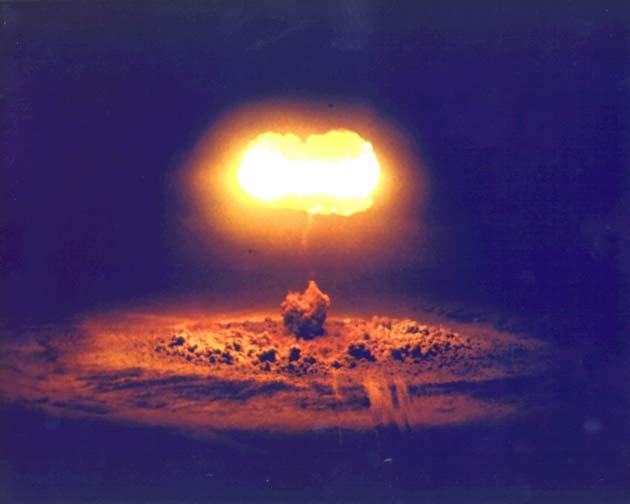Small Nuclear War Would Cause Global Environmental Catastrophe

SAN FRANCISCO—A small-scale, regional nuclear war could disrupt the global climate for a decade or more, with environmental effects that could be devastating for everyone on Earth, researchers have concluded.
The scientists said about 40 countries possess enough plutonium or uranium to construct substantial nuclear arsenals. Setting off a Hiroshima-size weapon could cause as many direct fatalities as all of World War II.
"Considering the relatively small number and size of the weapons, the effects are surprisingly large," said one of the researchers, Richard Turco of the University of California, Los Angeles. "The potential devastation would be catastrophic and long term."
The lingering effects could re-shape the environment in ways never conceived. In terms of climate, a nuclear blast could plunge temperatures across large swaths of the globe. "It would be the largest climate change in recorded human history," Alan Robock, associate director of the Center for Environmental Prediction at Rutgers' Cook College and another member of the research team.
The results will be presented here today during the annual meeting of American Geophysical Union.
Blast fatalities
In one study, scientists led by Owen "Brian" Toon of the University of Colorado, Boulder, analyzed potential fatalities based on current nuclear weapons inventories and population densities in large cities around the world.
Sign up for the Live Science daily newsletter now
Get the world’s most fascinating discoveries delivered straight to your inbox.
His team focused on the black smoke generated by a nuclear blast and firestorms—intense and long-lasting fires that create and sustain their own wind systems.
For a regional conflict, fatalities would range from 2.6 million to 16.7 million per country. "A small country is likely to direct its weapons against population centers to maximize damage and achieve the greatest advantage," Toon said.
Chilled climate
With the information, Robock and colleagues generated a series of computer simulations of potential climate anomalies caused by a small-scale nuclear war.
"We looked at a scenario of a regional nuclear conflict say between India and Pakistan where each of them used 50 weapons on cities in the other country that would generate a lot of smoke," Robock told LiveScience.
They discovered the smoke emissions would plunge temperatures by about 2 degrees Fahrenheit (1.25 degrees Celsius) over large areas of North America and Eurasia—areas far removed from the countries involved in the conflict.
Typically when sunlight travels through the atmosphere, some rays get absorbed by particles in the air, before reaching Earth's surface. After a nuclear blast, however, loads of black smoke would settle into the upper atmosphere and absorb sunlight before it reaches our planet's surface. Like a dark curtain pulled over large parts of the globe, the smoke would cause cool temperatures, darkness, less precipitation and even ozone depletion.
At the end of the 10 years, the simulated climate still hadn't recovered.
Global upshot
The study showed it doesn't take much nuclear power to drive meteoric results. Whereas the scenarios presumed the countries involved would launch their entire nuclear arsenals, that total is just three-hundredths of a percent of the global arsenal.
Will the conclusions result in worldly changes? "We certainly hope there will be a political response because nuclear weapons are the most dangerous potential environmental danger to the planet. They're much more dangerous than global warming," Robock said.
- Top 10 Ways to Destroy Earth
- Natural Disasters: Top 10 U.S. Threats
- Labs Compete to Make New Nuclear Bomb
- Video: Goldilocks and the Greenhouse
- All About Climate
Jeanna Bryner is managing editor of Scientific American. Previously she was editor in chief of Live Science and, prior to that, an editor at Scholastic's Science World magazine. Bryner has an English degree from Salisbury University, a master's degree in biogeochemistry and environmental sciences from the University of Maryland and a graduate science journalism degree from New York University. She has worked as a biologist in Florida, where she monitored wetlands and did field surveys for endangered species, including the gorgeous Florida Scrub Jay. She also received an ocean sciences journalism fellowship from the Woods Hole Oceanographic Institution. She is a firm believer that science is for everyone and that just about everything can be viewed through the lens of science.









